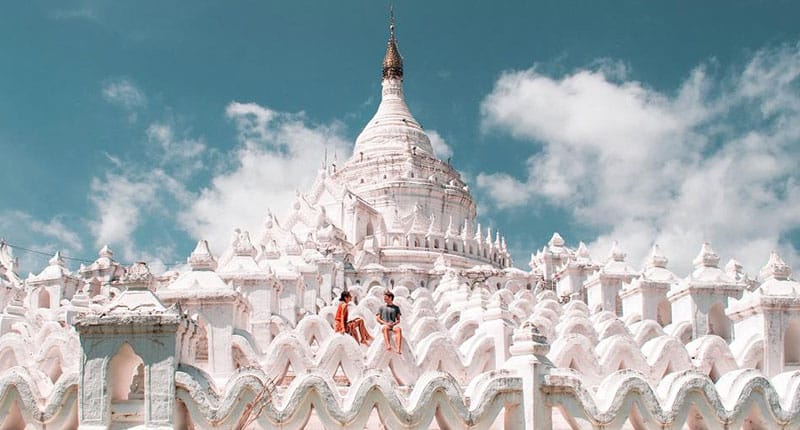The Hsinbyume Pagoda, also known as Myatheindan Pagoda, is a breathtaking religious site located near Mandalay, Myanmar. It stands out for its unique architectural design and stunning white terraces, making it one of the most mesmerizing pagodas in the world. In this article, we will delve into the rich history, architectural beauty, cultural significance, and local legends surrounding the Hsinbyume Pagoda.
The History of Hsinbyume Pagoda
The Hsinbyume Pagoda was built in 1816 by Bagyidaw, the seventh king of the Konbaung Dynasty, in memory of his first wife, Princess Hsinbyume. The princess tragically passed away during childbirth, and the pagoda was erected to honor her memory and her everlasting beauty. Over the centuries, the pagoda has become a significant pilgrimage site for Buddhists and a major tourist attraction.
Architectural Beauty and Symbolism
White Terraces
The Hsinbyume Pagoda is renowned for its striking white terraces, which represent the seven mountain ranges surrounding Mount Meru, the mythical center of the universe in Buddhist cosmology. As visitors ascend the terraces, they are believed to be progressing toward the sacred abode of the gods.
Seven Terraces and Seven Elements
The pagoda consists of seven terraces, each symbolizing one of the seven elements essential for life: earth, water, fire, air, space, consciousness, and wisdom. These elements hold profound significance in Buddhist teachings, emphasizing the interconnection of all living beings and the universe.
Cultural Significance
The Hsinbyume Pagoda holds immense cultural importance in Myanmar. It serves as a site for spiritual contemplation and meditation, attracting both devoted pilgrims and curious travelers from around the globe. The serene ambiance and artistic beauty of the pagoda create an atmosphere of tranquility and reflection.
How to Reach Hsinbyume Pagoda
To reach the Hsinbyume Pagoda, visitors must first travel to Mandalay, Myanmar’s second-largest city. From there, they can hire a taxi or join an organized tour to Mingun, a small town located on the western bank of the Irrawaddy River. The pagoda is a short walk from Mingun.
Best Time to Visit
The best time to visit the Hsinbyume Pagoda is during the dry season, which typically spans from November to February. The weather is mild and pleasant, providing an ideal environment for exploring the pagoda and its surroundings.
Nearby Attractions
While visiting the Hsinbyume Pagoda, tourists can explore other nearby attractions that add to the overall experience.
Mingun Pahtodawgyi
This unfinished pagoda is a colossal structure, originally intended to be the world’s largest. Despite being incomplete, it remains an impressive sight, showcasing the ambition of its construction.
Myatheindan Pagoda
Often referred to as the “Hsinbyume Pagoda’s Little Sister,” Myatheindan Pagoda boasts a similarly stunning white design. It offers a more compact version of the grandeur seen at the Hsinbyume Pagoda.
Mingun Bell
As one of the largest ringing bells in the world, the Mingun Bell is a must-see attraction. Cast in 1808, it has a remarkable history and is an important religious artifact.
Local Legends and Stories
The Hsinbyume Pagoda is steeped in captivating legends and stories that add to its allure.
The Legend of the White Elephant
Legend has it that Princess Hsinbyume’s pregnancy was prophesied by a white elephant. This auspicious event led to the construction of the pagoda as a tribute to her memory.
Princess Hsinbyume’s Story
The tragic story of Princess Hsinbyume’s untimely demise has been passed down through generations. Her life and beauty are celebrated and remembered at the pagoda.
The Mesmerizing View
From the top terrace of the Hsinbyume Pagoda, visitors are rewarded with a breathtaking panoramic view of the surrounding landscape. The Irrawaddy River flows serenely below, and the distant hills create a picturesque backdrop.
Tips for Visitors
- Dress Modestly: As a religious site, visitors should dress respectfully, covering their shoulders and knees.
- Remove Footwear: Shoes must be removed before ascending the terraces of the pagoda.
- Photography Etiquette: While photography is allowed, visitors should refrain from using flash and be mindful of others’ spiritual experiences.
- Respectful Behavior: Visitors should maintain a calm and quiet demeanor, respecting the sanctity of the pagoda.
Preserving the Beauty
Preservation efforts are vital to maintain the pristine beauty of the Hsinbyume Pagoda for future generations. Visitors are encouraged to follow the guidelines set by the local authorities and avoid any activities that could harm the pagoda or its surroundings.
Conclusion
The Hsinbyume Pagoda stands as a remarkable testament to the rich cultural heritage and architectural brilliance of Myanmar. Its symbolic significance and stunning beauty make it a captivating destination for travelers seeking spiritual enlightenment and aesthetic wonder. Visiting this mesmerizing pagoda is an unforgettable experience that leaves a lasting impression on the hearts of those who make the journey.
FAQs
- Is the Hsinbyume Pagoda open to all visitors?
- Yes, the Hsinbyume Pagoda is open to visitors of all backgrounds. It welcomes both locals and tourists interested in exploring its cultural and architectural significance.
- Are there any entry fees to visit the pagoda?
- There is no entry fee to visit the Hsinbyume Pagoda. However, visitors can make donations to support the maintenance and preservation of the site.
- Can I take photographs at the pagoda?
- Yes, photography is permitted at the Hsinbyume Pagoda. However, visitors are advised to be respectful and avoid using flash to preserve the tranquil atmosphere.
- What is the significance of the white terraces?
- The white terraces of the pagoda symbolize the seven mountain ranges around Mount Meru, a sacred place in Buddhist cosmology.
- When is the best time to visit the pagoda?
- The best time to visit the Hsinbyume Pagoda is during the dry season, which typically spans from November to February. During this time, the weather is cool and pleasant, making it comfortable for visitors to explore the pagoda and its surroundings. Additionally, the clear skies offer breathtaking views from the top terrace, providing an unforgettable experience.
